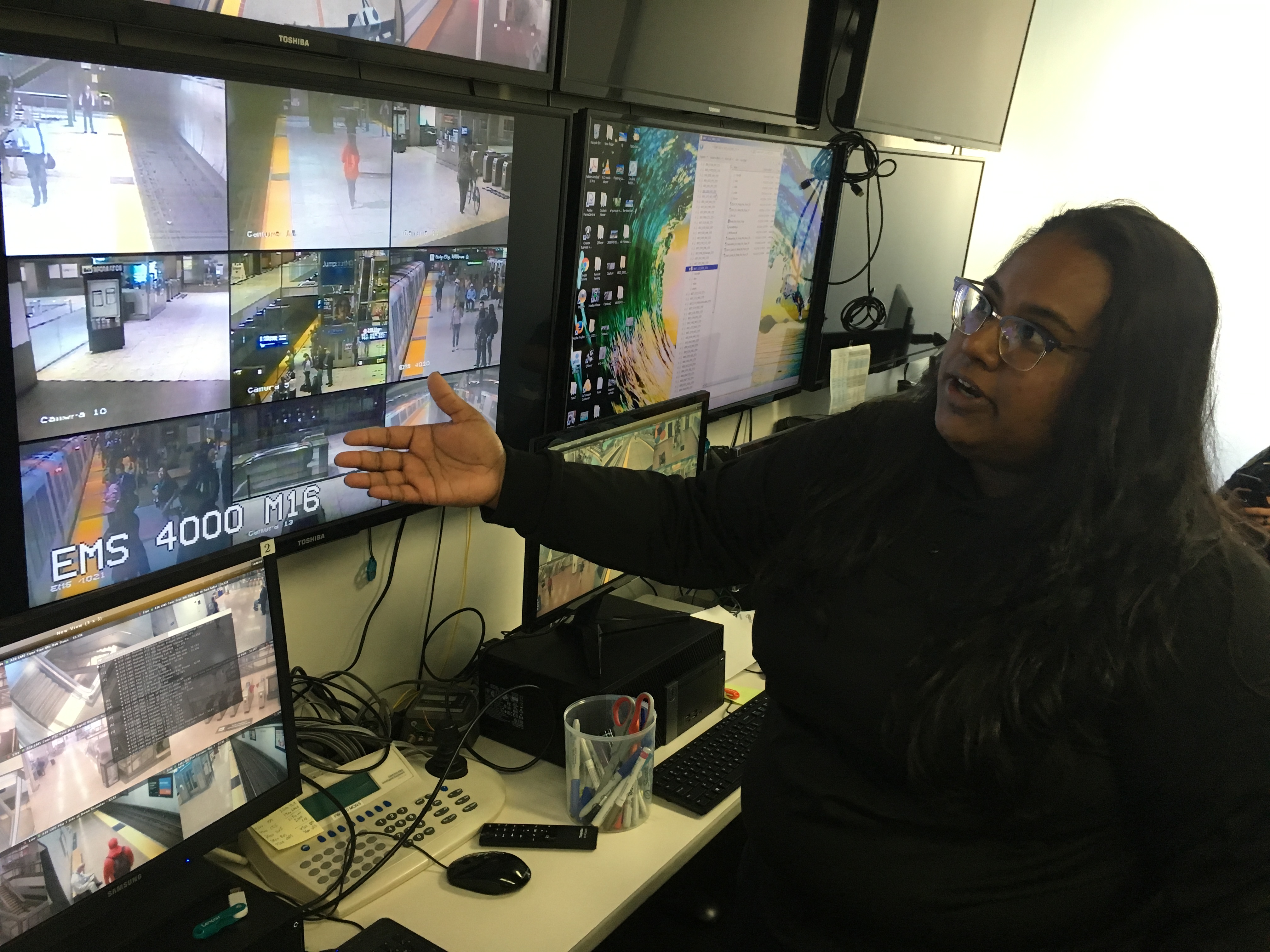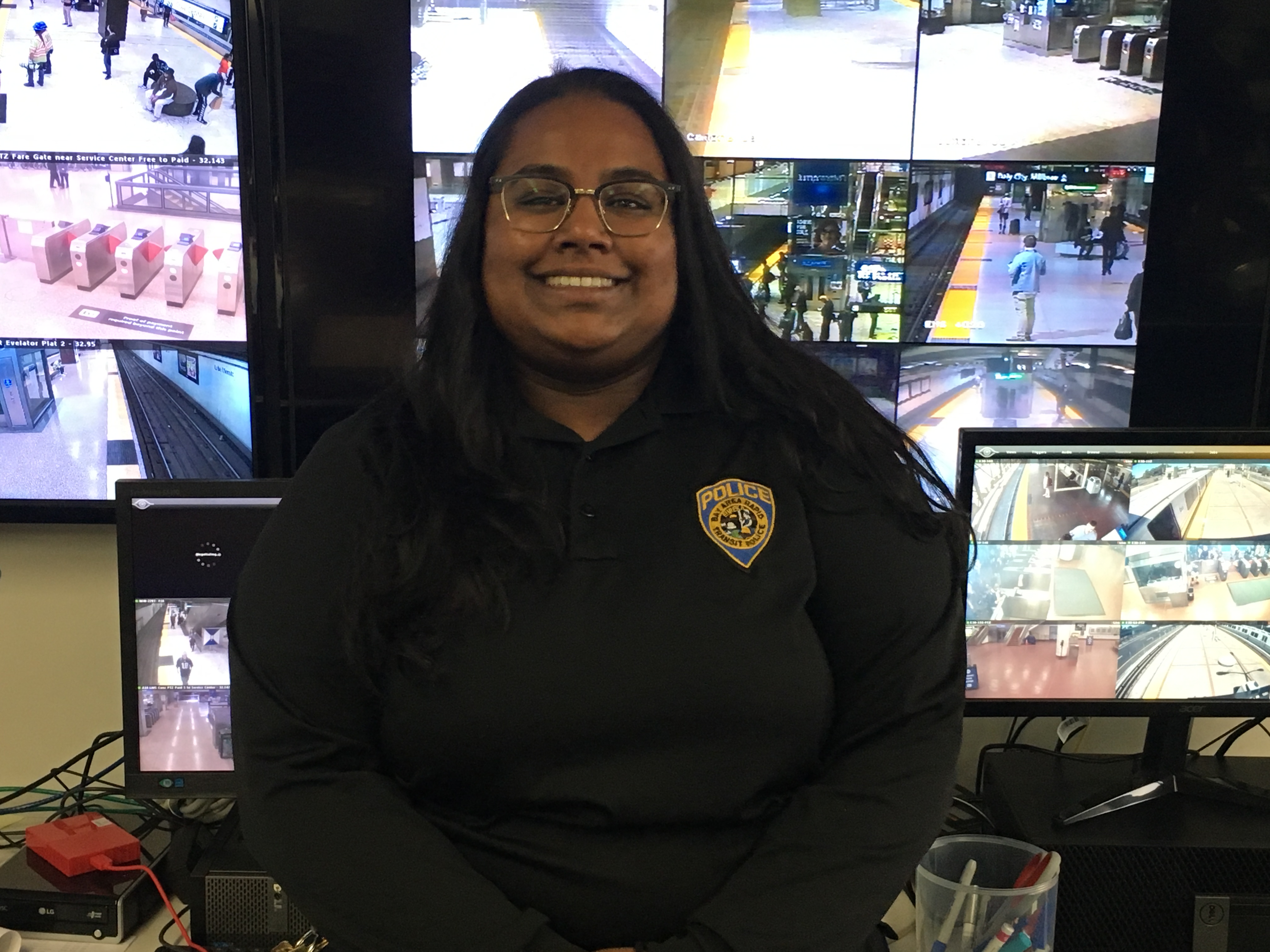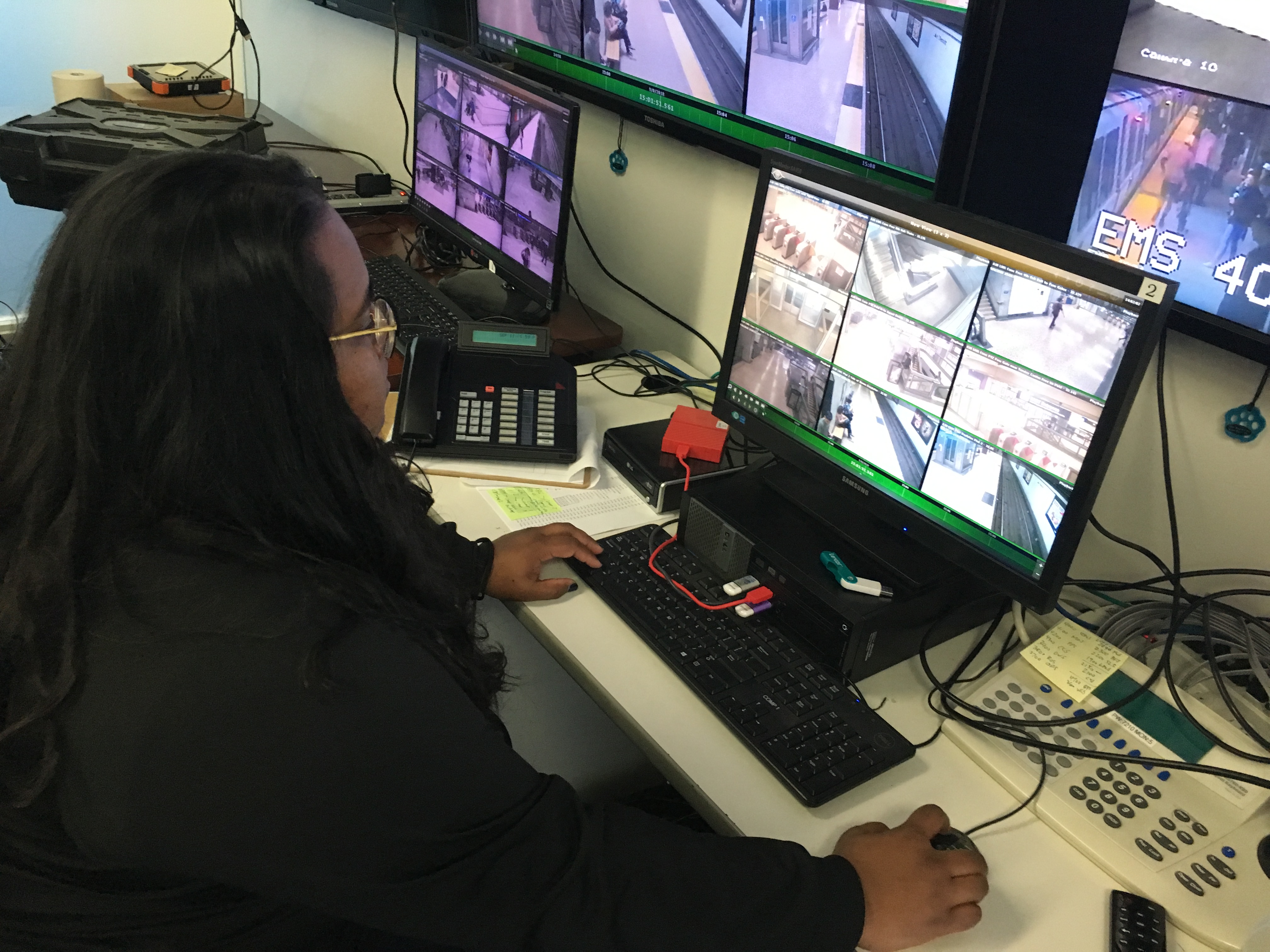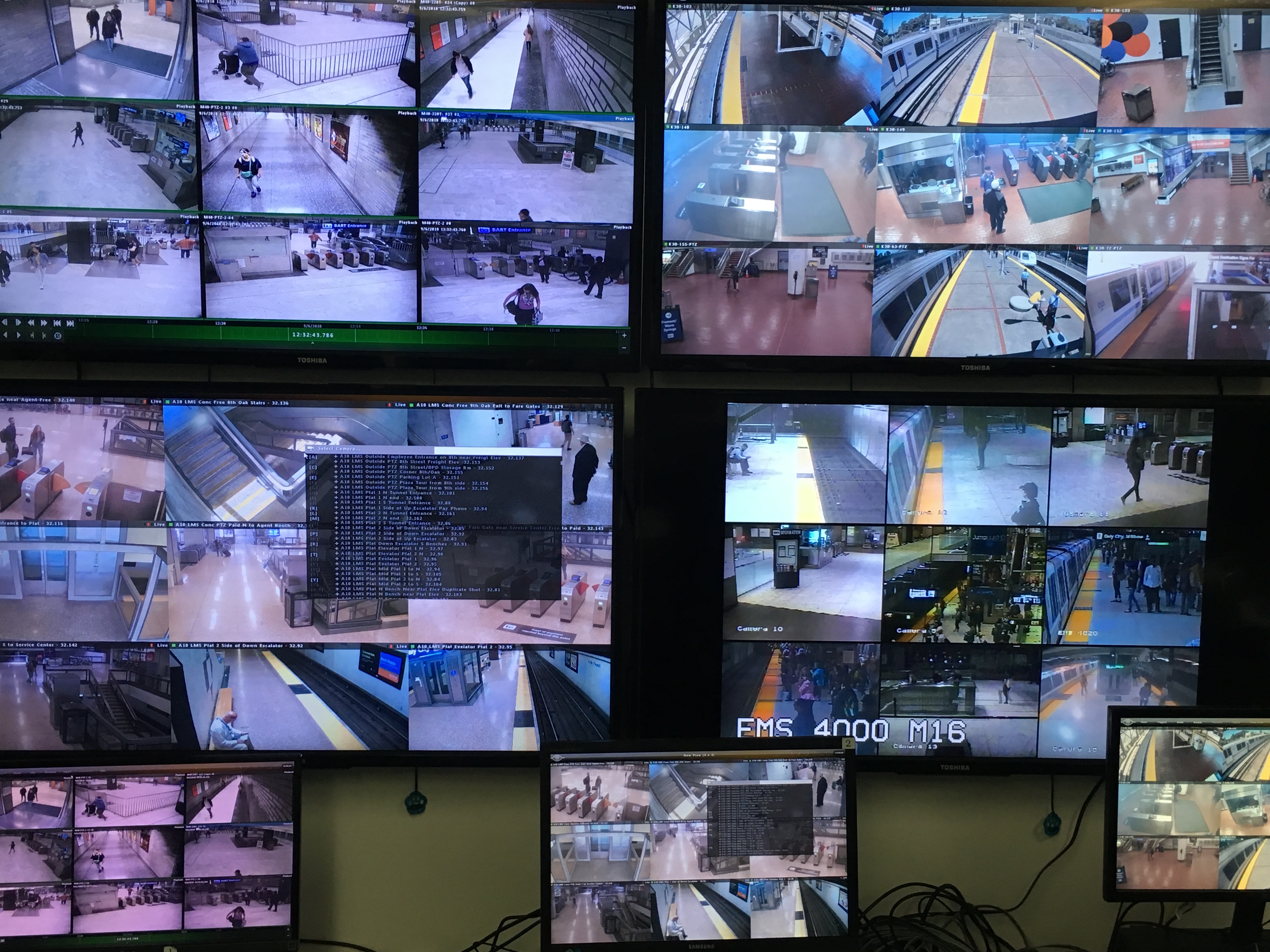Go inside BPD's video surveillance recovery room
BART has a robust video surveillance network. It includes working cameras on board all trains, in every station, and elsewhere throughout BART. But the reason BART police have been able to identify and arrest suspects in connection with several recent high-profile cases has as much to do with the technology as it does the people behind it. On this latest edition of our podcast series “Hidden Tracks: Stories from BART” you’ll hear from one of BPD’s Community Service Officers who specializes in finding key evidence contained on the video files recorded by BART’s cameras. She’s watched thousands of hours of surveillance and says it’s all worth it when it leads to an arrest that makes BART safer.
HOST: “And I’m now speaking with Aliyyah Shah a Community Service Officer with the BART Police Department. Aliyyah, thank you so much for speaking with us.”
SHAH: “Thank you for having us. We’re excited to be here.”
HOST: “We are basically now sitting in the nerve center of the video unit for the BART Police Department. Describe what it is that we’re looking at here with all of these screens in action.”
SHAH: “We have a large room here and we try to utilize our video wall. We have a video wall of about 10 50-inch TVs, they’re always carrying video. We have between six to ten computers at any given time recovering, reviewing. Basically, we use this system to look at anything in the system that has digital footage.”
HOST: “It’s impressive, especially from an outsider’s point of you. You look at these video screens, a lot of them you can break down into smaller screens, so you can see nine cameras on one screen. You’re literally monitoring dozens of feeds at the same time.”
SHAH: “If I use my binoculars I can have 64 feeds at any given time on the, tiny tiny feeds. But it can run an enormous amount of video. We have over 4,000 cameras in the system. We have digital, we have analog, we have an immense amount of video to watch and review and we can see anything.”
HOST: “How do you keep track of all this?”
SHAH: “In my mind. No, we have lists and lists of what we have. We also get a lot of experience and knowledge of the system just by interacting with it every day. So, it’s definitely something we get to learn.”
HOST: “I would imagine this is back by an awful lot of computing power. It’s not just video cameras and screens.”
SHAH: “We have buildings full of servers, basically. They store footage from our stations, from our trains, we have individual DVRs for those. Everything is recording, and we try to make everything record the best it can.”
HOST: “How big of a difference does it make having working video cameras on every train car?”
SHAH: “It has been amazing. It’s very challenging because we have to go out there and grab them, but it has been so rewarding. It has changed a great many things and it’s really amazing.”
HOST: “Now, you’ve been with BART for coming up on five years and you’ve been doing this sort of work with our video equipment. Do you get to the point with so much experience you essentially learn the system, you learn where the cameras are, you already have a sense that if something’s reported at a specific station you might have an idea which camera might have seen something important?”
SHAH: “That’s true. I’ve been doing this job for three years now. I’ve been with BART for five and a part of my first two years was working patrol, so I have a very intimate knowledge of the system itself just being out there patrolling, walking in the system, helping people. So, it’s really good that I’m able to apply that same knowledge to recovering video. As I said, it’s three years of constantly looking at these cameras. I have a great idea, when it comes to Civic Center, MacArthur, everything, Lake Merritt of course since we work right here so it’s really good to apply that same knowledge.”
HOST: “I bet and that has to be so critical because anytime we’re trying to solve a case timing is really important. So, anything that gives you an edge has to have value.”
SHAH: “We really try to find out where something is happening, how that person interacted with their environment, where they may have gone. We then use that knowledge of that station and the cameras to basically track people through the station. We can find where they’re going or where they came from pretty easily from most stations and it’s really nice because we can try to link that in to train car footage as well.”
HOST: “I’m speaking with Aliyyah Shah, a Community Service Officer with the BART Police Department talking about video technology and how the BART Police Department uses that to catch folks who commit illegal acts in our system. Kind of take us through the process, how does it work? When you get notified, there’s a significant crime in the system, what happens, how do you spring into action?”
SHAH: “I definitely try to identify what happened, where it happened, and get an idea of what I would need to get to first. Usually, that’s getting a better identification of the suspect. What exactly was the loss? If there was something distinctive about the suspect. We definitely try to apply our knowledge of the system and our cameras. We use multiple system to try and track the suspect. Usually, for me I come to the office here. Like I said, we have 10 TV screens on the go, multiple cameras, multiple systems, multiple computers ready to find this person. So, I usually come here, I report to my office right away. If it’s something like a train, sometimes I’ll report to a yard just to recover a train car first. I want something that will give us information on how to find the suspect as soon as possible.”
HOST: “An important part of your job is to find these images that we can release to the public to help identify a suspect but really your work goes well beyond that. You’re the eyes and ears of the BART Police Department. If you can get that information right away, you can get it to the officers and it can make a really big difference.”
SHAH: “We listen to the radio in here as well and even if we have a case that’s going on that doesn’t seem like very much is going on, yet we tend to tune in and really spring into action. We can turn a camera or move a camera to a special location that will capture what was going on. We tend to give updates, give further descriptions. We’ll help the officers on scene live. Same thing applies for when something has happened recently, and we rush in and we’re basically looking for the best information we can give.”
HOST: “Time is a factor here as well. The sooner you can get this information the better off, obviously for everyone. Do you feel that pressure of having to get this information and get these facts as quickly as you can?”
SHAH: “Oh definitely, I must have my coffee in the morning otherwise we’re definitely not going to do as well as we can. But on a more serious note, we do give our best effort when it comes to stuff like this. It's fulfilling. I go home every day and I feel like I’ve done everything I can, I’ve done 115%, and I give that every day. It’s a huge part of my job. It’s exactly what we want to do, and BART enables us to be able to perform this with so many cameras, so many computers, everything is just working away and it really helps us feel like we’re doing something good.”
HOST: “I would think it would take a certain type of person to be successful at a job like this and dealing with deadline pressure, that ability to get information fast, that ability to have that technology savvy must really come into play here. In other words, this job isn’t necessarily for everyone.”
SHAH: “I would think that’s true. A lot of my co-workers tease me because I know the camera numbers. A lot of our cameras we just don’t even have time to name them and they’re like, ‘what do you mean you know that’s camera 41?’ ‘Well, it is look,’ and they look and sure it is, it’s camera 41. But I definitely think it’s experience becoming familiar with it, constantly working with it every day. We work with our engineer to improve the system every day. I think we’re doing everything we can in terms of that. But, for me it’s so fulfilling. It’s part of that whole thing, just getting the pictures, getting the right angle. It matters. If you want a wide angle, if you want a zoomed-out view of something, if something’s happened somewhere we try to improve that view. It’s constant work, it’s great.”
HOST: “That must be a really important thing as well is that institutional knowledge of the system. Like we were talking about before, more than 4,000 cameras out there, we have dozens of stations in the system. There’s a lot to keep track of and if you can have that knowledge where you can name off an individual camera number that has to go a long way for you.”
SHAH: “Definitely, I have my favorites, I have my go-to cameras at certain stations that I start with. I tend to work from that camera and I’ll go out and try to piece it all together and then I’m obsessive about having it in the right order. So, we work closely with the system, this is our go-to when it comes to finding something in the system, it’s amazing. We definitely help outside agencies with our cameras as well. Sometimes we have to work from the outside in to the station, sometimes we work from the inside out. It’s pretty awesome.”
HOST: “I’m speaking with Aliyyah Shah, a Community Service Officer with the BART Police Department. We’re in the video unit at the BART Police Department Headquarters. I just have to imagine you’ve been a CSO for almost five years, you’ve been doing this sort of work for BART PD for about three years. You must’ve seen a ton of video. How many cases have you worked on where you’ve reviewed surveillance video?”
SHAH: “I would say thousands. I would say double-digit thousands comfortably. Every case that we have our officers can request video for depending on the severity of the incident, the time frame of the incident. From that, we usually try to get a best description of the location this happened in and we pull video for everything we need to. Everything from stolen bike to stolen vehicles to everything that happens in the system, even if it’s just a safety question about whether something happened, something didn’t happen. Does this light switch work? Anything like that, it doesn’t matter. Every department at BART can request video from us for their purposes, for safety. We also work closely with outside agencies so counting that, thousands and thousands and thousands of cases. We work tirelessly to get this video out there to who needs it for their investigative purposes and it’s definitely rewarding to be able to provide that to them.”
HOST: “I want to pick up on that idea of working with outside agencies because it does get to the quality of the images that are produced by the cameras in our surveillance system. We release images to the public and a lot of times those images have played an important role in resulting in an arrest. Now we also have images that are shared with local law-enforcement agencies, partner agencies in the Bay Area and that’s been very useful. What would you say about the quality of the images that the BART surveillance system produces because it feels like many of those images are getting results?”
SHAH: “Every day I would say we work with some agency in the Bay Area. We work with OPD, we work with federal agencies like the FBI and they’re always extremely pleased with the quality of the images. It helps them solidify their cases and they work with us for cases that we need help with. They piece together their evidence, we show them what we have, and it definitely can evolve into something amazing like closing huge cases.”
HOST: “Rider safety has obviously been a really popular topic when it comes to BART. Really all across the Bay Area so many people are talking about whether or not BART is safe. When you talk to your friends and they ask you if BART’s safe, knowing what you know being part of this department, working in this unit with the video surveillance, what do you tell them?”
SHAH: “I think it’s super safe. I take BART, my wife takes BART, I think it’s an amazing system. We get to go here, there, everywhere in the Bay Area and it’s really affordable. You can avoid all the traffic, I think it’s great. I come in and out of these stations every day and I’m always looking at these cameras going, ‘I know I’m looking at this one.’ It’s nice, I feel like I’m at home when I come to BART because I’m so intimate with the system and I feel like we’re doing everything we can for the public, so I don’t have any problem riding the system. I think it’s great.”
HOST: “When we hear about Community Service Officers at BART a lot of time CSOs are associated with parking enforcement, we think about CSOs doing focused fare enforcement, that sort of thing. But here you are in the video unit you’re part of the investigative team so that’s a little bit different.”
SHAH: “We tend to do any little auxiliary tasks we can. We supplement the police department. We’re there to do cold reports, we do community-oriented policing. We definitely try to be out there and present. We like to think we’re at the forefront where officers are responding call to call to call. We’re there to supplement that and fill in where needed. So, we do many different special assignments as well as regular patrol work, we write tickets. We also, like I said before, we do eyes and ears. We’re looking out for the public, we’re answering questions, we’re trying to be there whenever we’re needed.”
HOST: “I guess it’s one of the timeless challenges of police work where witnesses will see things a certain way, memories fade, all these sorts of factors come into play. They may not necessarily have a clear recollection of what happened with a particular event. But when you have something on video camera, you essentially have direct evidence. You have something you can see, that doesn’t change that can show you what happened on a train or platform in our stations. I would think even beyond the images we get of suspects that must be really important for the investigation. In other words, you can describe for detectives, you can show them what happened even if it’s not necessarily a situation where you’re getting an image of a suspect like a facial picture for example.”
SHAH: “A picture’s worth a thousand words. Body language is easily detected on our system because our pixilation count is so good, our frames per second is so good. We can see things, even if it’s in a dark area we can see a silhouette. We understand things like, it’s just as important to get what the victim might have been wearing because if you find them you’re able to find the suspect and when they interact. So, we use the system in a unique way. We go from frame to frame to frame and we’re looking for many different things. Like I said, it’s worth a thousand words. You don’t need to see the entire thing to get what’s going on, but we try to paint the best picture we can because it’s important to tell the right story. So, even if the victim has trouble recalling what’s going on, if we can get a little snippet of what’s going on we try out best to find the incident that happened and how it happened and capture that.”
HOST: “There’s a whole conversation going on right now as BART takes various steps to promote public safety about upgrading our video surveillance system. Specifically, moving some cameras from analog to digital, upgrading to the highest quality possible. I think it’s important to keep in mind also that part of the process of getting this video is you actually have to go out and get that tape so you’re able to review it.”
SHAH: “Definitely, I love having to go grab it but it’s really nice if we have it her locally or somewhere central where we can go get it. I think for the train cars, it’s really rewarding to have the video available to us in first place. Even if we have to get it it’s worth having it. As for upgrading the analog to digital, the more the merrier. Keep it all. Sometimes the most obscure camera catches the best things. It’s really, I think we can do so much better if we just more, more, more.”
HOST: “That’s definitely the approach. I’m speaking with Aliyyah Shah, a Community Service Officer with the BART Police Department. What’s the most challenging part of your job?”
SHAH: “I think it’s making sure I capture whatever happened. It’s difficult to find the right camera, it’s difficult to paint the right picture of what’s going on. I think the challenge for me is to make sure I find it as fast as possible and get it to the people who need it. That’s always a challenge, making sure we have the right resources, we’re able to get the detectives and the officers the information they need. Nothing’s more frustrating than if a camera is down or if a system isn’t working so we really try our best to make sure everything is working, everything’s functioning. That’s my biggest challenge to make sure it’s all there when I need it.”
HOST: “I would imagine that’s a concern potential having blind spots out there. Do we do a decent job of responding to that? How does that work?”
SHAH: “We do a surprisingly amazing job with that. We have some many turns and different entrances at stations, so much coverage is caught on our system it’s really amazing how well we’ve excelled at that. I think we do a great job. Not everything is going to be filmed in 360 but it’s pretty amazing how well we supplement our system with great angles and cameras.”
HOST: “It’s interesting in this era of cellphones it feels like there are video cameras everywhere but they’re really not. You really need those stationary cameras because you never know what you might miss if one isn’t in the proper position.”
SHAH: “That’s correct. We’ll take any kind of video but even in this cellphone era like you say it’s certainly no replacement for the kind of cameras we have. They are super powerful, we even use 4K cameras at some of our stations and we’re constantly improving. We’re constantly replacing older cameras with newer cameras and trying out new things so it’s great.”
HOST: “Do you think people who might do bad things on our system realize just how many cameras are out there and could potentially see them?”
SHAH: “I’d like them to know that we’re watching and we’re there for our patrons. I don’t think you could commit a crime on BART that we can’t find you.”
HOST: “How satisfying is it for you when you play that role in helping to identify a suspect. You get that information, you get that image that plays a pivotal role in leading to an arrest.”
SHAH: “It is the most, one of the most important things I do and it’s so fulfilling. Working with our detectives, working with our officers for the safety of our patrons, you can’t get much better than that. It’s like every day is rewarding because we’re capturing these images and providing the public with a better place to be. Like I said before, there’s nothing better than catching someone doing something they shouldn’t and going out there and apprehending them before they hurt someone else or do something else bad.”
HOST: “What do you think is the most important thing for our riders to know about BART’s surveillance system.”
SHAH: “It is extremely robust. We have so many cameras. I think it’s good for the public to know that we’re looking, we’re watching, we care about what’s going on in the system, we’re constantly trying to improve the system, and we need their cooperation. We want you to tell us what’s going on. We want you to tell us what train car you were on. Let us know where in the station you were when this happened. Don’t be afraid to report crime. We’re trying to solve what we can. We’re definitely working hard to fix anything that would be wrong in the system.”
HOST: “Aliyyah, thank you so much for your time and thank you so much for all you do to make BART just that must safer.”
SHAH: “Thank you so much.”
HOST: “Aliyyah Shah is a Community Service Officer with the BART Police Department. And thank you for listening to ‘Hidden Tracks: Stories from BART.’ You can listen to our podcasts on SoundCloud, iTunes, Google Play, Stitcher, and of course at our website bart.gov/podcasts.”



